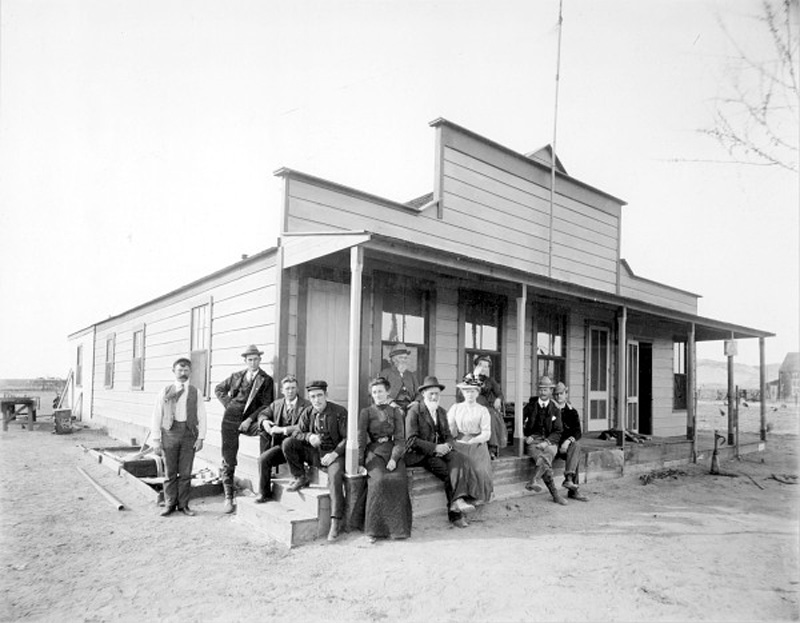|
|
Rosamond | Mojave Desert

The Stuckey building in Rosamond, c. 1890. Built in the 1880s, this was the desert community's first commercial structure. It housed a three-room hotel, a post office and a general store. According to contributor David Desmond it was occupied as a residence, after its commercial use, by George and Ella Kenton. Mr. and Mrs. Rawley Duntley lived in the structure following Ella Kenton's death. It was moved to the Goldcamp Museum at Burton's Tropico Gold Mine Tours in Rosamond following Rawley Duntley's death in the 1960s. The building now sits on Glenn Settle's property at the Tropico gold camp. Glenn and his late wife Doreen Settle have been historians of the Antelope Valley for decades. Photo by Pierce & Co., 313 S. Spring St., Los Angeles; acquired by SCV Historical Society member David Desmond in an auction of the Tropico Goldcamp Museum's contents.
Rosamond, est. 1877, is located in the Mojave Desert. Out of Santa Clarita, take Highway 14 north past Lancaster. The Tropico Gold Mine opened in the 1890s as the Lida Mine. It thrived throughout the first decades of the 20th Century until the late 1950s, by which time the cost of extracing the gold nearly equalled the fixed market price of the yellow metal ($35 per ounce). Its owners turned it into a touristy ghost down but shut it down in the mid-1980s, again amid rising costs — this time in the form of insurance premiums. Today the privately owned property is fenced off — no trespassing. Occasionally the property is used for filming (e.g., "Ocean's Thirteen" starring George Clooney, 2007). According to a 1971 letter by Arnold Munz, one of the structures "on exhibition at Glen Settles' Gold Mine at Rosamond" is "the old, original house that my father built." It is unclear whether Munz is referring to a house his father built in Palmenthal (Old Palmdale) or at the Munz homestead in the Elizabeth Lake area.
Rosamond and the Tropico Gold Mine From: Final PEIR (Programmatic E.I.R.): North Los Angeles-Kern County Recycled Water Project (2008) The city of Rosamond was another depot on the Southern Pacific Rail Line in 1876 and a trading post for local mines. First known as Bayle Station or Baylesville after postmaster David Bayles (1885), the town was later renamed Rosamond (Rosamond County Library vertical file, n.d.). Rosamond town site lots were obtained from the Southern Pacific by an E.H. Seymour in 1904 and sold to a C.C. Calking three years later (Settle, 1967), who then "sold the mortgage to Charles M. Stinson, who in turn presented [deeded] it to the Union Rescue Mission of Los Angeles who foreclosed the mortgage in 1916. In 1935, the Rescue Mission began selling lots in the townsite, later presenting the remaining property to the community" (Darling, 2003). Prior to the settling and eventual development of Rosamond, Tropico Hill was being mined for clay by Dr. L.A. Crandall who purchased the mine in 1882. Hamilton renamed the mine "Hamilton Hill" and during the course of the clay-mining activities, gold was discovered. Having changed names again, the then known "Lida Mine" was sold to the Antelope Mining Company in 1908 and again to the Tropico Mining and Milling Company in 1909. Eventually the mine was acquired by the Burton brothers in 1912, who were former employees of the Tropico Mining and Milling Company. For a brief period between 1942 and 1946, in support of World War II wartime mining efforts, the mine closed. Once the war was past, the mine reopened and remained in operation until 1956. The Tropic Gold Mine was "one of the most successful gold mines in California" (Cunkelman, 2001). DD1891: 9600 dpi jpeg from 600 dpi jpeg of copy print |
The site owner makes no assertions as to ownership of any original copyrights to digitized images. However, these images are intended for Personal or Research use only. Any other kind of use, including but not limited to commercial or scholarly publication in any medium or format, public exhibition, or use online or in a web site, may be subject to additional restrictions including but not limited to the copyrights held by parties other than the site owner. USERS ARE SOLELY RESPONSIBLE for determining the existence of such rights and for obtaining any permissions and/or paying associated fees necessary for the proposed use.





